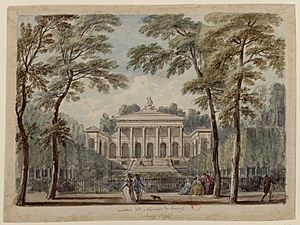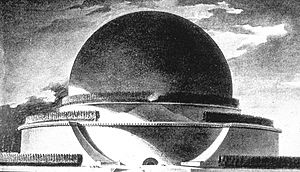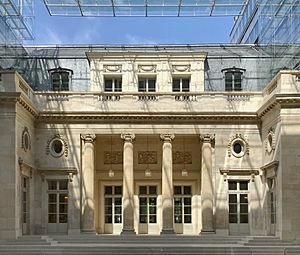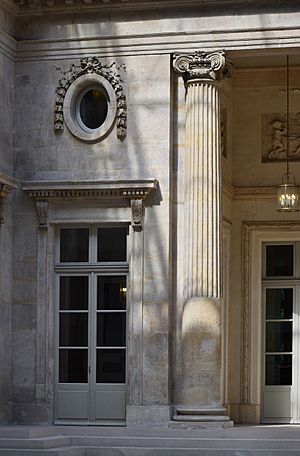Étienne-Louis Boullée facts for kids
Quick facts for kids
Étienne-Louis Boullée
|
|
|---|---|
| Born | 12 February 1728 Paris, France
|
| Died | 4 February 1799 (aged 70) Paris, France
|
| Occupation | Architect |
| Practice | Neoclassicalism |
| Buildings | Hôtel Alexandre |
Étienne-Louis Boullée (born February 12, 1728 – died February 4, 1799) was a famous French architect. He lived during a time when people were very interested in the ideas of ancient Greece and Rome, which led to a style called Neoclassicism. Boullée had many big and bold ideas for buildings, even though many of them were never actually built. His designs were so unique that they greatly influenced other architects of his time and even much later.
Contents
Life of Étienne-Louis Boullée
Étienne-Louis Boullée was born in Paris, France. He learned about architecture from famous teachers like Jacques-François Blondel and Germain Boffrand. They taught him about the classic French building styles from the 1600s and 1700s, and also about the newer Neoclassical style that was becoming popular.
In 1762, Boullée became a member of the Académie Royale d'Architecture, which was a very important group for architects. He also received an honorary title as the chief architect for Frederick II of Prussia, a king. From 1762 to 1778, he designed several private homes. Most of these buildings no longer exist today. However, the Hôtel Alexandre in Paris is one of his designs that you can still see. Boullée, along with another architect named Claude Nicolas Ledoux, became one of the most important figures in French Neoclassical architecture.
Boullée's Geometric Style
Boullée had a huge impact as a teacher and a thinker at the École Nationale des Ponts et Chaussées (a famous engineering school) between 1778 and 1788. During this time, he developed his own special style of architecture.
His style used simple, abstract geometric shapes, like circles and squares, inspired by ancient Roman and Greek buildings. He believed in removing all extra decorations and making geometric forms incredibly large. He also liked to repeat elements, such as columns, in long rows. For Boullée, the most important rules for architecture were:
- Regularity (everything in order)
- Symmetry (balanced on both sides)
- Variety (different interesting parts)
The Newton Memorial
Boullée believed that a building's design should show its purpose. He called this idea architecture parlante, which means "talking architecture." It was like the building itself was telling you what it was for.
One of his most famous designs, which was never built, was a cenotaph (a monument for someone buried elsewhere) for the English scientist Isaac Newton. Newton was a symbol of new ideas during Boullée's time.
Boullée's design for Newton's memorial was a giant sphere, about 150 meters (500 feet) tall. This is even taller than the Great Pyramids of Giza! The sphere was surrounded by two large walls and hundreds of cypress trees. Boullée loved the sphere shape because he thought it was the most beautiful and perfect natural form.
Inside the sphere, a small tomb for Newton was placed at the bottom. Boullée designed the memorial to create the effect of both day and night. During the "night" effect, sunlight would shine through small holes in the ceiling, making it look like stars in the night sky. For the "day" effect, a glowing sphere hung in the center, giving off a mysterious light. This clever use of light made the building's inside look different at various times.
Hôtel Alexandre
The Hôtel Alexandre (also called Hôtel Soult) in Paris is the only one of Boullée's house designs that still exists today. It was built between 1763 and 1766 for a rich financier named André-Claude-Nicolas Alexandre.
In the main courtyard, you can see four Ionic columns set into the wall, creating an entrance. The doors on the sides of the courtyard have simple openings with decorations above them. Above these, there are oval windows decorated with hanging plant designs, which were common in the Neoclassical style. The back of the house, facing the garden, has tall columns that rise from the ground floor all the way up.
Boullée's Legacy
Boullée's ideas had a big impact on other architects who were learning from him, such as Jean Chalgrin and Alexandre-Théodore Brongniart.
Many of his most important works were not known until the 1900s. His book, Architecture, essai sur l'art ("Essay on the Art of Architecture"), was published in 1953. In this book, he wrote about his ideas for an emotional and powerful Neoclassicism. The book included many of his designs from 1778 to 1788, which were mostly for huge public buildings that were too big to actually build.
Because Boullée loved such grand designs, some people called him a "megalomaniac" (someone who wants everything to be huge). But others saw him as a true visionary. He was very innovative in how he used opposite design elements (polarity) and how he played with light and shadow in his buildings. These ideas still inspire architects today. He was "rediscovered" in the 1900s and has influenced modern architects like Aldo Rossi.
The movie The Belly of an Architect (1987) by Peter Greenaway is about a made-up architect who is putting on an exhibition about Boullée's work. The film shows many visual ideas from Boullée's designs.
See also
 In Spanish: Étienne-Louis Boullée para niños
In Spanish: Étienne-Louis Boullée para niños






